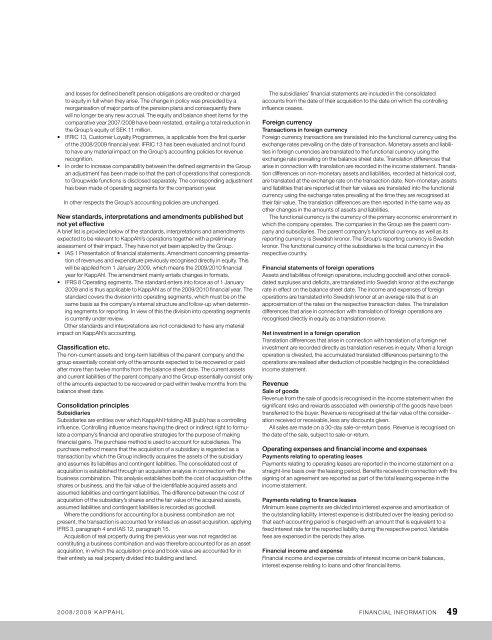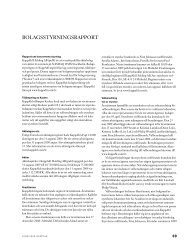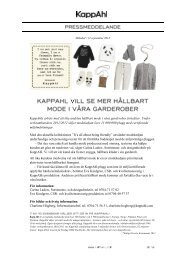We - KappAhl
We - KappAhl
We - KappAhl
Create successful ePaper yourself
Turn your PDF publications into a flip-book with our unique Google optimized e-Paper software.
and losses for defined benefit pension obligations are credited or charged<br />
to equity in full when they arise. the change in policy was preceded by a<br />
reorganisation of major parts of the pension plans and consequently there<br />
will no longer be any new accrual. the equity and balance sheet items for the<br />
comparative year 2007/2008 have been restated, entailing a total reduction in<br />
the Group’s equity of SEK 11 million.<br />
• IFRIC 13, Customer Loyalty Programmes, is applicable from the first quarter<br />
of the 2008/2009 financial year. ifric 13 has been evaluated and not found<br />
to have any material impact on the Group’s accounting policies for revenue<br />
recognition.<br />
• In order to increase comparability between the defined segments in the Group<br />
an adjustment has been made so that the part of operations that corresponds<br />
to Groupwide functions is disclosed separately. the corresponding adjustment<br />
has been made of operating segments for the comparison year.<br />
in other respects the Group’s accounting policies are unchanged.<br />
New standards, interpretations and amendments published but<br />
not yet effective<br />
a brief list is provided below of the standards, interpretations and amendments<br />
expected to be relevant to Kappahl’s operations together with a preliminary<br />
assessment of their impact. they have not yet been applied by the Group.<br />
• IAS 1 Presentation of financial statements. Amendment concerning presentation<br />
of revenues and expenditure previously recognised directly in equity. this<br />
will be applied from 1 January 2009, which means the 2009/2010 financial<br />
year for Kappahl. the amendment mainly entails changes in formats.<br />
• IFRS 8 Operating segments. The standard enters into force as of 1 January<br />
2009 and is thus applicable to Kappahl as of the 2009/2010 financial year. the<br />
standard covers the division into operating segments, which must be on the<br />
same basis as the company’s internal structure and follow-up when determining<br />
segments for reporting. in view of this the division into operating segments<br />
is currently under review.<br />
other standards and interpretations are not considered to have any material<br />
impact on Kappahl’s accounting.<br />
Classification etc.<br />
the non-current assets and long-term liabilities of the parent company and the<br />
group essentially consist only of the amounts expected to be recovered or paid<br />
after more than twelve months from the balance sheet date. the current assets<br />
and current liabilities of the parent company and the Group essentially consist only<br />
of the amounts expected to be recovered or paid within twelve months from the<br />
balance sheet date.<br />
Consolidation principles<br />
Subsidiaries<br />
Subsidiaries are entities over which Kappahl holding aB (publ) has a controlling<br />
influence. controlling influence means having the direct or indirect right to formulate<br />
a company’s financial and operative strategies for the purpose of making<br />
financial gains. the purchase method is used to account for subsidiaries. the<br />
purchase method means that the acquisition of a subsidiary is regarded as a<br />
transaction by which the Group indirectly acquires the assets of the subsidiary<br />
and assumes its liabilities and contingent liabilities. the consolidated cost of<br />
acquisition is established through an acquisition analysis in connection with the<br />
business combination. this analysis establishes both the cost of acquisition of the<br />
shares or business, and the fair value of the identifiable acquired assets and<br />
assumed liabilities and contingent liabilities. the difference between the cost of<br />
acquisition of the subsidiary’s shares and the fair value of the acquired assets,<br />
assumed liabilities and contingent liabilities is recorded as goodwill.<br />
Where the conditions for accounting for a business combination are not<br />
present, the transaction is accounted for instead as an asset acquisition, applying<br />
ifrS 3, paragraph 4 and iaS 12, paragraph 15.<br />
acquisition of real property during the previous year was not regarded as<br />
constituting a business combination and was therefore accounted for as an asset<br />
acquisition, in which the acquisition price and book value are accounted for in<br />
their entirety as real property divided into building and land.<br />
the subsidiaries’ financial statements are included in the consolidated<br />
accounts from the date of their acquisition to the date on which the controlling<br />
influence ceases.<br />
Foreign currency<br />
Transactions in foreign currency<br />
foreign currency transactions are translated into the functional currency using the<br />
exchange rates prevailing on the date of transaction. monetary assets and liabilities<br />
in foreign currencies are translated to the functional currency using the<br />
exchange rate prevailing on the balance sheet date. translation differences that<br />
arise in connection with translation are recorded in the income statement. translation<br />
differences on non-monetary assets and liabilities, recorded at historical cost,<br />
are translated at the exchange rate on the transaction date. non-monetary assets<br />
and liabilities that are reported at their fair values are translated into the functional<br />
currency using the exchange rates prevailing at the time they are recognised at<br />
their fair value. the translation differences are then reported in the same way as<br />
other changes in the amounts of assets and liabilities.<br />
the functional currency is the currency of the primary economic environment in<br />
which the company operates. the companies in the Group are the parent company<br />
and subsidiaries. the parent company’s functional currency as well as its<br />
reporting currency is Swedish kronor. the Group’s reporting currency is Swedish<br />
kronor. the functional currency of the subsidiaries is the local currency in the<br />
respective country.<br />
Financial statements of foreign operations<br />
assets and liabilities of foreign operations, including goodwill and other consolidated<br />
surpluses and deficits, are translated into Swedish kronor at the exchange<br />
rate in effect on the balance sheet date. the income and expenses of foreign<br />
operations are translated into Swedish kronor at an average rate that is an<br />
approximation of the rates on the respective transaction dates. the translation<br />
differences that arise in connection with translation of foreign operations are<br />
recognised directly in equity as a translation reserve.<br />
Net investment in a foreign operation<br />
translation differences that arise in connection with translation of a foreign net<br />
investment are recorded directly as translation reserves in equity. When a foreign<br />
operation is divested, the accumulated translated differences pertaining to the<br />
operations are realised after deduction of possible hedging in the consolidated<br />
income statement.<br />
Revenue<br />
Sale of goods<br />
revenue from the sale of goods is recognised in the income statement when the<br />
significant risks and rewards associated with ownership of the goods have been<br />
transferred to the buyer. revenue is recognised at the fair value of the consideration<br />
received or receivable, less any discounts given.<br />
all sales are made on a 30-day sale-or-return basis. revenue is recognised on<br />
the date of the sale, subject to sale-or-return.<br />
Operating expenses and financial income and expenses<br />
Payments relating to operating leases<br />
payments relating to operating leases are reported in the income statement on a<br />
straight-line basis over the leasing period. Benefits received in connection with the<br />
signing of an agreement are reported as part of the total leasing expense in the<br />
income statement.<br />
Payments relating to finance leases<br />
minimum lease payments are divided into interest expense and amortisation of<br />
the outstanding liability. interest expense is distributed over the leasing period so<br />
that each accounting period is charged with an amount that is equivalent to a<br />
fixed interest rate for the reported liability during the respective period. Variable<br />
fees are expensed in the periods they arise.<br />
Financial income and expense<br />
financial income and expense consists of interest income on bank balances,<br />
interest expense relating to loans and other financial items.<br />
2008/2009 Kappahl financial information 49





